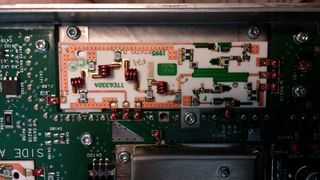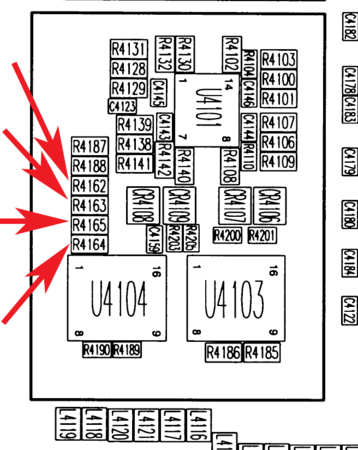First Generation PA
The Quantar First Generation UHF Power Amps cover UHF R1, R2, R3 and R4. R0, 380-433 MHz, was a slight redesign, and it is covered else where.
Contents
Basics
The Basic module is pictured below.
The major parts of the PA are
- Printed circuit board
- Intermediate PA
- Final PA
- Circulator
- Low Pass Filter
Each of these parts varies depending on the range of the PA.
| Band | IPA | FPA | Circulator | LPF |
|---|---|---|---|---|
| R1 | TLE9150 | TTE6321 | 5884911T04 | TTE6331 |
| R2 | TLE9150 | TTE6322 | 5884911T04 | TTE6332 |
| R3 | TLE9160 | TTE6323 | 5884911T18 | TTE6334 |
| R4 | CLE6090 | TTE6342 | 5884911T18 | TTE6334 |
The IPA module is a 10 W output that feeds into the FPA. Note the schematic diagram has some errors on it regarding a 30-35W output from the IPA. This is an error as it's from the 25W UHF PA diagram.
The FPA module consists of two parallel PA strips with two FET's each for a total of four devices. Each strip is addressed as "A" and "B" in the radio for the current monitoring of the PA.
Unfortunately there is no diagram of the IPA or FPA modules.
Note there is no CPU or even much digital circuitry in the PA. All metering is done via the exciter CPU mostly using an analog input and switches (U4103/4) to switch this input between different voltages on the PA.
The exciter controls the output power by an analog output (V_CONT) 0-5v from the CPU. This voltage is then used to control a couple transistors (Q4100 & Q4101) making the V_OMNI voltage that varies the first stage in the Intermediate PA.
The complete schematics are PNG format and are also available as a
PDF
Pictures
This is a UHF R2 Generation 1 PA I took pictures of.
Conversions
PA ID is done via a resistor "ROM". This is a voltage divider on an analog input on the exciter. It appears to be in half volt increments and the exciter split must match the PA.
Note the arrangement of R4164 and R4165 in the layout, they do not go in order!
| PA Type | PA_ID_A | PA_ID_B | R4162 | R4163 | R4164 | R4165 |
|---|---|---|---|---|---|---|
| UHF 110W R0 | 0.0 | 1.5 | OPEN | 0 | 390 | 1k |
| UHF 110W R1 | 1.0 | 0.5 | 15k | 1.5k | 560 | 10k |
| UHF 110W R2 | 1.5 | 0.5 | 1k | 390 | 100 | 1k |
| UHF 110W R3 | 3.0 | 1.0 | 2.2k | 2.7k | 1.5k | 15k |
| UHF 100W R4 | 3.5 | 1.0 | 18k | 15k | 1.5k | 15k |
R1 to R2
Converting from a R1 to R2 is quite easy.
The major components will cover the R2 band fully. The IPA and circulator are the same with only the FPA and LPF being different.
The FPA will cover the 8.6% frequency difference with out any appreciable difference. It's been tested at the W9CR labs at 438 and 470 MHz for 24+ hours of key-down with no noticeable difference. The R1 and R2 FPA pallets are almost identical as well.
The LPF is different but there is not any problem with using it for R2. The insertion loss of the LPF is only .3 dB more at 470 MHz and it appears to work just fine. Both LPF, R1 & R2 were swept with key data points taken as you can see below.
The only thing necessary to convert the R1 to R2 is to change the ID resistors.
R2 to R1
Should be the same as R1 to R2
R3/4 to R2
Never attempted. The IPA, FPA, LPF and circulator are different. I would assume the IPA and FPA would be good. The circulator most likely needs to be changed, and harmonics checked, as the LPF cutoff is higher.
If anyone wants to try it and document it, please add it.
R3 to R4 or R4 to R3
Never attempted. The IPA, and FPA are different, but most likely will work as it's a ~5.4% frequency shift. The circulator and LPF are identical on these units so it should be only a matter of changing the ID.































